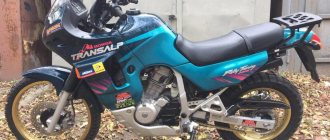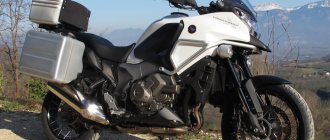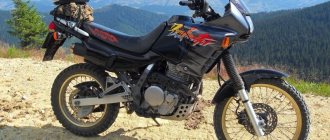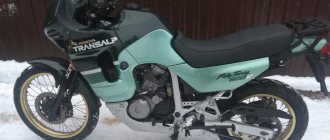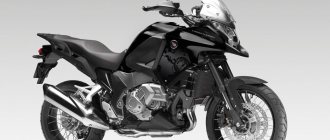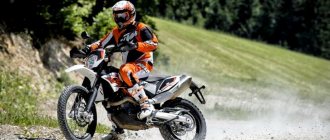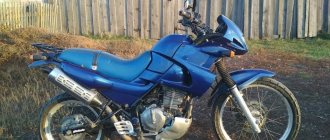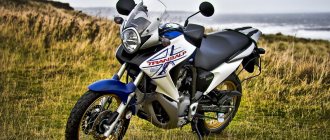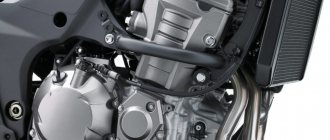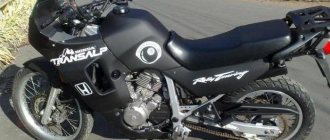- Honda motorcycle model
The Honda XL 650 V Transalp enduro touring motorcycle model was produced from 2000 to 2007. and replaced the previous generation of Transalp - Honda XL600V Transalp. Unlike its predecessor, the new model had a more modern appearance, a new dashboard, a new exhaust system, 2-disc front brakes, a more powerful engine and less off-road suspension.
The main feature of the Honda XL650V Transalp is a 2-cylinder V-shaped 6-valve liquid-cooled engine producing 53 hp. power and 55 Nm of torque. Like previous generations of the motorcycle, the engine of the 650 cc Transalp is tuned for smooth traction from low and medium speeds, showing maximum performance at 5500-7500 rpm. This engine was not a new development, but migrated from the Honda Bros 650 model and was also installed on the Honda NT 650 Deauville tourist.
Other features of the Honda XL650V Transalp include a classic steel frame, a 5-speed gearbox, a double-disc front brake, a chain drive, simple suspension in the form of a conventional telescopic fork and a monoshock absorber, and 191 kg of dry weight.
Bike features
Here are the main features of the Honda XL 650 V Transalp:
- the gas tank is significantly larger in volume than average;
- new, more stylish design (compared to the 600th model);
- presence of an alarm button.
All this and some other points make the motorcycle one of the best representatives of modern enduro for touring. However, the bike is also well suited for the city, except that buying such a motorcycle just for riding on the streets is not practical.
Photo gallery
If you are a born traveler, and your life is dear, then you need to look for a universal iron horse that will be ready to go any route. As we have already found out, the Honda Transalp 650 motorcycle is a good option for this; you can see its external data in our small selection.
Engine
The motor of this Transalp is not a unique development for a specific model. It was derived from a Honda Deauville 650, a pretty serious touring bike. This is a V-type unit, it is four-stroke and two-cylinder. Its displacement reaches 647 cm³, and its compression ratio is 9.2:1. The engine receives liquid cooling. Each cylinder has 3 valves, which was also typical for its predecessor. The fuel supply system is carburetor.
Torque at its peak at 5500 rpm is 56 Nm, while power at its maximum at 7500 reaches 55 hp. Peak speed for a motorcycle is 172 km/h. The XL 650 V accelerates to 100 km/h in just 5.1 seconds, which is quite respectable for a touring enduro of impressive dimensions.
Trouble-free Transalp?
Despite this, Transalp has won a large group of supporters. This is not surprising, because this is a trouble-free machine, strong and durable. And although the motorcycle looks ridiculous, you need to try hard to break it. In addition, it is a very comfortable motorcycle, not very demanding to use, and it is easy to turn into an adventure, because the range of accessories and the number of patents that make life easier for this motorcycle are enormous.
Unfortunately, the motorcycle also has shortcomings that have not disappeared despite the years and are frightening in each subsequent version. The most significant of these is the tendency to shimmy. Steering vibration appears around 80-90 km/h, and increases when driving with a central trunk.
Another disadvantage of the Honda XL700V is the low standard window glass, which is best immediately replaced with another, and poor engine protection from below. If you drive on asphalt only on a dirt road, the second problem will not apply to you, but if you like trekking, remember that the bottom cover is made of plastic, not sheet metal!
A solution that makes life a little more difficult for off-road enthusiasts is ABS, which cannot be switched off. On asphalt the system works brilliantly, but on gravel it is dull, but you have a simple solution - remove the fuse.
Transalps XL 700 V was sold in Russia about 300. These were versions RD 13A and RD 13B (2008 and 2009), as well as RD 15A and RD 15B (2010-2011). The first was produced in Spain, the second in Italy, and the letters A and B mean versions without ABS and with ABS, respectively.
Although the instrumentation does not resemble that of a farm tractor, Honda could make it better and, above all, more pleasant.
Dimensions and weight
The weight of the motorcycle is significant: for a fully fueled bike it is as much as 212 kg. The seat height is 843 mm, so for short people this option will be a little more comfortable than the XL 600 V. The wheelbase dimensions are 1505 mm. The motorcycle itself is very tall – as much as 1315 mm. The length and width are also quite large: 2260 mm and 920 mm, respectively.
The fuel tank capacity of the XL 650 V is 19.6 liters. Of these, 3.5 liters are reserve. This is a significant volume, allowing you to travel many kilometers without constantly thinking about the nearest gas station. Gasoline consumption per 100 km of road is relatively low and amounts to only 5.2 liters.
Typical disadvantages
Transalp does not have the typical disadvantages. The only service campaign for the "700" was announced in 2008. It touched the ring in which the piston of the rear master cylinder was mounted - it happened that during braking it did not return to its original position and, as a result, the pads rubbing against the disc overheated it. The defective items were replaced under warranty and the problem was resolved.
On the Internet I came across information about problems with radiator fans, front suspensions and spark plugs that are sensitive to moisture. Although these were isolated cases.
As for previous versions, in the “600”, from the very first years of production, ignition modules were installed under the seat. Their forks were positioned in such a way that the movement of the sofa would damage them over time, and the motor would stop supplying a spark to one of the cylinders. The recipe here is horizontal mounting of modules.
In turn, “650” discovered a problem with the radiator wires and, as part of a service campaign in 2002, corrected their fastening. Both versions suffered from a plastic speedometer that wore out rather quickly, which failed at high mileage.
Chassis and brakes
The bike is equipped with a steel half-duplex frame. It looks impressive, which cannot be said about many other touring enduros. The stylish colors correspond to the purpose of the motorcycle, but do not make its appearance too pretentious. The wheels are spoked, and the steering wheel, in addition to being comfortable and made of steel, also has protection for the driver’s fingers.
The rear suspension is a pendulum version with a monoshock absorber. Its stroke is 187 mm. The front suspension is a telescopic fork with a travel of 200 mm. Its dimensions are 41 mm. The brakes at the rear are a 240 mm disc with a single-piston caliper, while at the front there are two discs, each 256 mm, and the calipers are two-piston.
Tire selection
By default, Transalpas are equipped with a rear wheel measuring 130/80–17, but installing tires from “Goose”, which is only 1 cm wider (140/80–17), will not affect handling at all, but increases the tire life by 25 percent -thirty. For primarily road use with rare trips to graders and dry primers, tires of the previous generation are suitable - Metzeler Tourance, Michelin Anakee 2, Conti Escape. They will more or less provide grip on any surface and will last a long time. If you rarely leave the asphalt, then it is better to choose modern models Tourance Next, Anakee 3, Pirelli Scorpion Trail 2, Continental Trail Attack 2. They keep the asphalt at the level of sports-touring tires on road motorcycles, but this is achieved at the expense of off-road qualities.
These motorcycles are used less often for off-roading than their “bigger” brothers, however, toothy tires can be found. Human-tested options would be the Conti TKC-80 Twinduro, Metzeler Karoo-3, Michelin Anakee Wild, Pirelli Scorpion Rally.
Don't turn your nose up at second-tier manufacturers. For example, the Shinko E705 has proven itself to be excellent for asphalt and light off-road use, while the more toothy E804–805 is suitable for serious off-road use. They both have a reasonable price, long life and good grip properties, and the money saved can be invested in wind protection and heated grips - this will be more useful on a long journey.
Tires for both the Transalp and the F 650/700 GS can always be found in stock without any problems - the sizes are standard, there is no shortage, there is always plenty to choose from.
www.motorezina.ru
Spices for internal combustion engines. Part 2 > July 22, 2022 07:28 Mikhail Pimus
Tuning
The entire range of accessories and additional components for the Transalp revolves around enhancing the touring and off-road potential of the motorcycle. The list of parts is impressive - from all kinds of luggage cases and windshields to protective bars, additional lights, heating and navigators. Everything in general has a positive effect on consumer characteristics and, what is important, practically does not impair service life and reliability.
